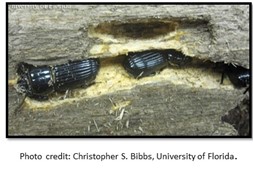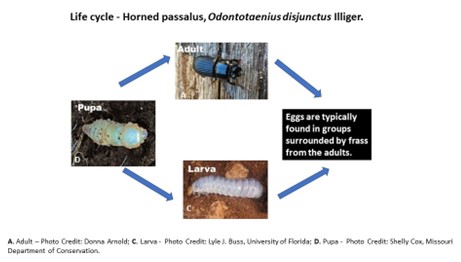Have you ever been strolling through your garden and decide to rearrange or remove a log? You might be amazed or intimidated by the sight of a dark shiny creature with large mandibles (mouth parts). But don’t be alarmed- it is the Horned Passalus, Odontotaenius disjunctus. This beetle also is known by many other common names including the Betsy Beetle, Bess Bug, Patent Leather Beetle, Jerusalem Beetle, Horn Beetle, and Peg Beetle.
This beetle is a widely distributed from mid-Florida to Massachusetts, Southern Texas to Minnesota, and Nebraska. Beetles are easily recognized due to their large size, ranging between 30 and 40 mm (1.2 and 1.6 inches) in length. They are known to have pre-social activities, where both males and females perform the same duties of processing decaying wood and protecting larvae.
Friend or foe?
Horned Passalus Beetles are beneficial decomposers of decaying wood or logs, often found in large numbers to efficiently complete the task! However, they are medically harmless and not considered a pest of urban structures. Horned passalus beetles are considered to be beneficial insects as these beetles help decompose deadwood by chewing the pulp and then expelling the frass.
Musically inclined or just a talkative beetle?
The phrase “crazy as a Betsy Bug” may refer to the sounds that these insects make — The adults are able to produce at least 17 different calls (Stridulation) as they communicate with other beetles or when disturbed/agitated, which are audible to humans.
Life cycle/ Developmental stage.
Using its large mandibles, the horned passalus cuts into fallen logs and creates tunnels where the eggs are deposited and hatched into white grubs (larvae) that have up to three instars. They appear to only have two pairs of legs, but a third pair is present and reduced. Only the first two pairs are used for movement. These grubs usually retain a distinctive C-shaped position when not active.
As pupae begin to form they become pearly white with a rainbow sheen. As the pupae age, they lose their rainbow sheen and can range in color from off white to earth-toned. Adult beetles aggregate and compete for sections of fallen wood.
Nuptial flight or defense?
Newly mature adults will leave the parent log and participate in a nuptial flight, one of the only instances of their wing use. During observations of the nuptial flight, adults were found to be susceptible to light attractants such as light traps and street lights. At the end of the nuptial flight, adults will seek out a new log to start another aggregation.
For more information, please contact your local county extension office.
Supporting information for this article can be found in the UF/IFAS EDIS publications/websites below: horned passalus – Odontotaenius disjunctus (Illiger) (ufl.edu); EENY 487/IN879: Horned passalus, Odontotaenius disjunctus (Illiger) (Insecta: Coleoptera: Passalidae: Passalinae) (ufl.edu) and Odontotaenius disjunctus (tamu.edu)
- Winter Bliss and Climate Challenges in North Florida Gardens - December 11, 2025
- When the Ground Moves. - September 25, 2025
- Kalanchoe Species in Florida: Invasive Threats and Management - August 15, 2025



